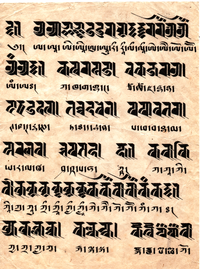lany+dza: Difference between revisions
Jump to navigation
Jump to search
mNo edit summary |
mNo edit summary |
||
| Line 1: | Line 1: | ||
[[File:Lanydza alphabet.png|200px|thumb| | [[File:Lanydza alphabet.png|200px|thumb||Lany+dza script alphabet]] | ||
'''lany+dza''' (ལཉྫ)- SA ''lañja'' (लञ्ज) - "tail or foot" <ref> Monier-Williams, Monier; (1889); ''Sanskrit-English Dictionary'' ([http://www.ibiblio.org/sripedia/ebooks/mw/0900/mw__0928.html p. 928]) </ref>. 1. Name of an Indic script,(लञ्जलिपि "tailed script") which first appeared at the time of the Pala dynasty, and sometimes used in Tibet for decoratively writing Sanskrit Buddhist mantra and dhāraṇī. Frequently also used on the title pages of Tibetan texts for writing the Sanskrit title of the work. | '''lany+dza''' (ལཉྫ)- SA ''lañja'' (लञ्ज) - "tail or foot" <ref> Monier-Williams, Monier; (1889); ''Sanskrit-English Dictionary'' ([http://www.ibiblio.org/sripedia/ebooks/mw/0900/mw__0928.html p. 928]) </ref>. 1. Name of an Indic script,(लञ्जलिपि "tailed script") which first appeared at the time of the Pala dynasty, and sometimes used in Tibet for decoratively writing Sanskrit Buddhist mantra and dhāraṇī. Frequently also used on the title pages of Tibetan texts for writing the Sanskrit title of the work. | ||
Latest revision as of 03:47, 7 October 2021
lany+dza (ལཉྫ)- SA lañja (लञ्ज) - "tail or foot" [1]. 1. Name of an Indic script,(लञ्जलिपि "tailed script") which first appeared at the time of the Pala dynasty, and sometimes used in Tibet for decoratively writing Sanskrit Buddhist mantra and dhāraṇī. Frequently also used on the title pages of Tibetan texts for writing the Sanskrit title of the work.
2. The name used in Tibet for the what in Newar language is called the Rañjanā script. (CJF)
Note: often misspelled as lany+tsha (ལཉྪ)
